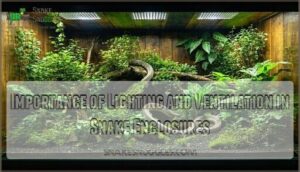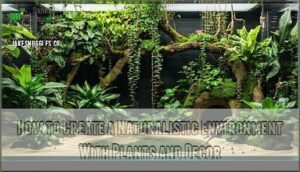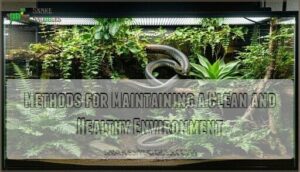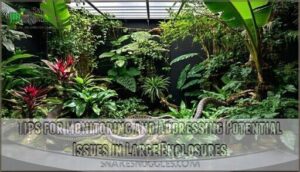This site is supported by our readers. We may earn a commission, at no cost to you, if you purchase through links.
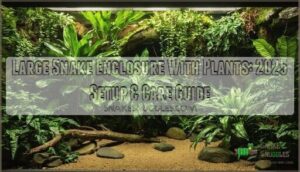 You’ll create a stunning large snake enclosure with plants by combining spacious dimensions with carefully chosen vegetation that serves multiple purposes.
You’ll create a stunning large snake enclosure with plants by combining spacious dimensions with carefully chosen vegetation that serves multiple purposes.
Live or artificial plants provide essential hiding spots, regulate humidity levels, and offer natural climbing opportunities for your snake.
The key is selecting plants that won’t harm your snake if consumed – pothos, snake plants, and bromeliads work well for live options, while high-quality artificial alternatives eliminate safety concerns entirely.
Your large setup allows for creative plant placement that mimics natural habitats, reducing stress and encouraging natural behaviors.
The secret lies in balancing plant selection with proper lighting, drainage, and maintenance protocols.
Table Of Contents
- Key Takeaways
- Large Snake Enclosures
- Top 5 Snake Enclosure Plants
- Creating Snake Friendly Environments
- Managing Large Snake Enclosures
- Frequently Asked Questions (FAQs)
- Can your snake enclosure be too big?
- How to keep plants alive in a snake enclosure?
- What plants are best for snake enclosure?
- What humidity levels work best for planted enclosures?
- How often should substrate be completely replaced?
- Can live plants survive under heat lamps?
- Which fertilizers are safe around large snakes?
- How to prevent mold growth in humid environments?
- Conclusion
Key Takeaways
- You’ll need at least 8’L x 4’W x 4’H dimensions for snakes over 8 feet to prevent stress and health problems – cramped spaces lead to behavioral issues and reduced feeding response.
- Choose snake-safe plants like pothos, snake plants, and bromeliads for live options, or go with high-quality artificial plants to eliminate toxicity concerns while still providing climbing opportunities and hiding spots.
- Maintain 60-80% humidity with proper ventilation, dual heat sources, and regular monitoring using digital hygrometers to keep both your snake and plants thriving in the ecosystem.
- You’ll need consistent maintenance including daily spot-cleaning, weekly deep cleaning, and monitoring for stress signals like excessive activity or feeding refusal to catch problems early.
Large Snake Enclosures
You’ll need a substantial enclosure when housing large snakes, as cramped spaces lead to stress and health problems.
Most species exceeding 8 feet require enclosures measuring at least 8’L x 4’W x 4’H, with semi-arboreal species needing extra vertical space for climbing, which helps prevent health issues due to inadequate space.
Benefits of Spacious Environments for Snakes
Giving your snake ample space isn’t just nice—it’s essential for Snake Behavior and Reptile Wellness.
Spacious enclosures aren’t luxury—they’re the foundation of snake health and happiness.
A large snake enclosure lets your pet stretch fully, explore naturally, and stay physically fit.
Environmental Enrichment through proper Habitat Design reduces stress while supporting healthy movement patterns.
When you provide adequate Spatial Needs, you’re investing in your snake’s long-term health and happiness.
Proper reptile enclosure design is vital for promoting the well-being of captive snakes.
Factors to Consider When Choosing an Enclosure Size
Several key factors will determine your snake’s happiness and health in their new home. You’ll need to balance space requirements with practical considerations like cost and room availability.
When setting up a large snake enclosure, researching and investing in proper snake enclosure kits is vital.
- Snake Behavior: Consider your species’ activity level and natural habitat preferences
- Enclosure Materials: Choose durable, non-toxic materials that support proper ventilation systems
- Humidity Control: Verify that materials won’t warp or degrade in high-moisture environments
- Ventilation Systems: Plan airflow patterns that prevent stagnant air in your large snake enclosure
How to Determine The Ideal Enclosure Size for Your Snake
You’ll need to calculate your snake’s adult size first, then apply proven measurement techniques for ideal space allocation.
Start by measuring your snake’s current length along its back using a flexible tape measure. When setting up the enclosure, consider the reptile care guidelines to guarantee a healthy environment.
| Snake Length | Minimum Enclosure Dimensions (L x W x H) |
|---|---|
| 3-4 feet | 48" x 24" x 24" |
| 4-5 feet | 60" x 30" x 30" |
| 5-6 feet | 72" x 36" x 36" |
| 6-8 feet | 96" x 48" x 48" |
| 8+ feet | 120" x 60" x 60" |
These habitat requirements guarantee your snake can stretch fully and display natural behaviors in their large snake habitat.
Top 5 Snake Enclosure Plants
You’ll want to choose plants that can handle your snake’s climbing habits and the humid environment of a large terrarium.
The right artificial plants provide natural-looking coverage while requiring zero maintenance, making them perfect for busy snake owners who value low-maintenance solutions.
1. Reptile Terrarium Artificial Plant Decorations
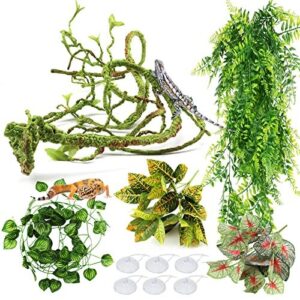
Anyone can transform their snake’s habitat with reptile terrarium artificial plant decorations that bring natural beauty without the hassle.
You’ll love how these non-toxic plastic plants create realistic hiding spots and climbing opportunities for your snake.
They’re waterproof, bendable, and incredibly easy to clean—just rinse with water or use a soft brush.
These decorations maintain their vibrant colors indefinitely while providing essential enrichment that encourages natural behaviors like exploration and territorial marking in your large enclosure.
Best For: Reptile owners seeking low-maintenance, realistic habitat decorations that provide enrichment and hiding spots for snakes, lizards, chameleons, and other terrarium pets.
- Maintenance-free design requires no watering, lighting, or pruning while maintaining vibrant colors indefinitely
- Non-toxic, waterproof materials ensure safety for reptiles with easy cleaning using just water or a soft brush
- Flexible, bendable construction allows customization to fit any enclosure size while providing climbing opportunities and hiding spots
- Initial chemical odor may require soaking in soap before first use to eliminate smell
- Suction cups may not adhere properly to all surfaces, potentially causing decorations to fall
- Foam material on jungle vines can tear with excessive bending and may not support heavier reptiles
2. Artificial Plants for Reptile Tanks
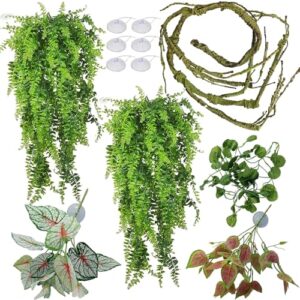
Because artificial plants eliminate concerns about toxicity and plant maintenance, they’re perfect for snake owners who want beauty without the hassle.
You won’t worry about your snake nibbling on something dangerous or dealing with dying foliage that creates cleaning headaches.
These non-toxic plastic alternatives provide realistic visual appeal while withstanding heavy use from large snakes who love to wrap around branches.
They’re waterproof, durable, and offer climbing opportunities without the risks.
Best For: Snake owners who want realistic-looking habitat decoration without the risks and maintenance requirements of live plants.
- Non-toxic materials eliminate poisoning risks while providing safe climbing and hiding opportunities for large snakes
- Waterproof and durable construction withstands heavy use from wrapping and active reptiles without breaking down
- Zero maintenance required – no watering, trimming, or dealing with dying foliage that creates cleaning problems
- Strong artificial smell may require thorough washing and airing out before installation
- Suction cups may not hold securely for larger, more active snakes without additional zip-tie reinforcement
- Some units arrive with broken leaves, and chemical odors can persist despite cleaning efforts
3. Reptile Terrarium Climbing Vine Plants
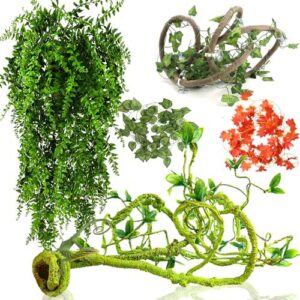
Looking beyond ground-level plants, climbing vines transform your large snake enclosure into a three-dimensional playground.
These flexible decorations encourage natural exploration behaviors while creating essential hiding spots throughout the vertical space.
You’ll find iron wire cores wrapped in soft PU material that bends easily around branches or decorations.
The realistic texture won’t harm your snake’s scales during climbing sessions, and most sets include multiple lengths – typically 40 to 79 inches – letting you customize complex pathways that make even the most sedentary species want to explore their expanded territory with the help of natural exploration behaviors.
Best For: Snake owners looking to create vertical enrichment in large terrariums while encouraging natural climbing behaviors in both arboreal and terrestrial species.
- Bendable iron wire core with soft PU coating allows customizable pathways that won’t damage snake scales during exploration
- Multiple piece sets (up to 79 inches per vine) create complex three-dimensional climbing structures throughout the enclosure
- Durable construction withstands repeated use by heavier snakes while maintaining realistic texture and appearance
- Some units emit a noticeable plastic odor that may require washing before installation in snake enclosures
- Included suction cups don’t adhere reliably to all terrarium surfaces, potentially requiring additional mounting solutions
- Green plastic hanging plants have harsh textures that may feel unnatural compared to the softer vine materials
4. Artificial Monstera Terrarium Plants Decor
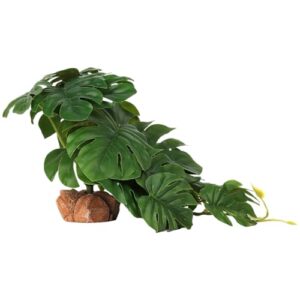
Several artificial Monstera plants bring tropical flair to your snake’s home.
These realistic plants feature the signature split-leaf design that creates perfect hiding spots and climbing opportunities.
With sturdy weighted bases, they won’t tip when your snake explores.
The WOLEDOE artificial Monstera measures 8.7" wide by 5.5" tall, making it ideal for medium enclosures.
You’ll love how easy they’re to clean—just wipe with a damp cloth.
Unlike live plants, they won’t wilt under heat lamps or require special care, giving you one less thing to worry about, and they are very low maintenance.
Best For: Snake owners seeking low-maintenance terrarium decor that provides climbing opportunities and hiding spots without the hassle of caring for live plants.
- Easy maintenance with simple damp cloth cleaning and no watering, fertilizing, or pruning required
- Durable construction with weighted base prevents tipping and withstands reptile activity
- Realistic split-leaf design creates natural-looking hiding spots and climbing surfaces for behavioral enrichment
- Smaller than expected at 8.7" wide by 5.5" tall, limiting use to medium-sized enclosures only
- Plastic material may not withstand high temperatures or direct heat sources
- Cannot provide air quality improvement or humidity benefits like live plants
5. Artificial Reptile Terrarium Hanging Plants
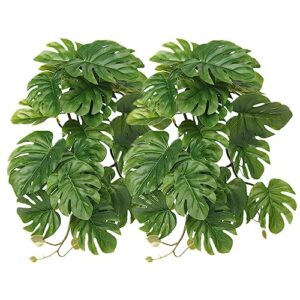
Beyond the usual ground-level décor, hanging plants transform your snake’s habitat into a three-dimensional playground.
These artificial climbing companions attach securely with suction cups, letting you create cascading vines that sway with movement.
You’ll love how they provide essential hiding spots while adding visual barriers that reduce stress.
The WOLEDOE Monstera models offer realistic textures without the maintenance headaches of live plants.
Just rinse them weekly to keep things hygienic—no watering, trimming, or pest control required.
For a more naturalistic environment, consider learning about safe plant species to create a thriving ecosystem.
Best For: Snake owners seeking low-maintenance terrarium enrichment that provides climbing opportunities and visual barriers without the hassle of live plant care.
- Leaves may detach under force and require occasional reattachment
- Limited flexibility – plants cannot be bent or reshaped once manufactured
- Some users report smaller dimensions than advertised and initial plastic odor requiring airing out
- Easy installation with strong suction cups and adjustable leaves for customizable habitat design
- No maintenance required beyond weekly cleaning – eliminates watering, trimming, and pest control
- Provides essential climbing surfaces and hiding spots that reduce reptile stress and encourage natural behaviors
Creating Snake Friendly Environments
You’ll create the perfect habitat when you balance temperature, humidity, lighting, and natural elements in your large enclosure.
Getting these environmental factors right means your snake will thrive while you enjoy watching them explore their planted paradise.
Tips for Maintaining Optimal Temperature and Humidity
After selecting the right plants for your large snake habitat, you’ll need to master the environmental controls that keep both your snake and greenery thriving. Think of your snake terrarium as a balanced ecosystem where every element works together.
- Temperature Control: Install dual heat sources—overhead ceramic heaters for basking spots and under-tank heating pads for belly warmth in your tropical snake house.
- Humidity Levels: Maintain 60-80% humidity using automated misting systems and water features that complement your snake plant enclosure design.
- Moisture Management: Position hygrometers at different heights to monitor gradients, ensuring proper moisture distribution throughout your vivarium design.
- Ventilation Systems: Install cross-flow ventilation with intake vents low and exhaust fans high to prevent stagnant air pockets. Effective temperature regulation relies on precise temperature control systems to maintain ideal conditions for your snake’s health.
Importance of Lighting and Ventilation in Snake Enclosures
Your snake needs proper lighting systems and ventilation types working together like a well-oiled machine.
UVB lighting supports natural behaviors while maintaining temperature control zones throughout your snake terrarium.
Quality air circulation prevents stagnant conditions that harm air quality and humidity management.
Choose LED fixtures for heat control and install fans or vents for your large snake habitat.
This combo creates the perfect vivarium design foundation.
How to Create a Naturalistic Environment With Plants and Decor
Creating your snake vivarium’s natural landscape starts with thoughtful Plant Selection. Choose snake friendly plants like pothos and sansevieria that withstand slithering.
Layer substrate depths for plant stability, mixing sand and orchid bark for proper drainage. Add climbing branches and cork bark for Decor Ideas.
Position artificial vines strategically throughout your plant filled vivarium. Include water bowls as Water Features.
Your reptile garden transforms into an indoor snake garden when you balance living elements with durable artificial additions. By incorporating elements that support snake conservation efforts, you can create a thriving environment for your pet snakes, focusing on snake friendly and natural landscape concepts.
Managing Large Snake Enclosures
Once you’ve set up your large snake enclosure with plants, you’ll need to master the ongoing care to keep everything thriving.
Managing both your snake’s health and your plants’ survival requires consistent attention to environmental factors and regular maintenance routines.
Strategies for Keeping Plants Alive and Thriving
Your plant filled vivarium needs consistent care to flourish alongside your snake. Success hinges on matching plant needs with your snake cage design requirements.
A thriving vivarium demands the perfect balance between your snake’s needs and your plants’ survival.
Here’s your indoor snake garden maintenance blueprint:
- Soil Quality & Water Management – Use well-draining reptile-safe substrates like ReptiSoil, checking moisture levels weekly to prevent root rot
- Humidity Control – Monitor with hygrometers, misting snake friendly plants while maintaining 60-80% humidity through substrate dampening
- Fertilization Methods – Apply natural, reptile-compatible fertilizers sparingly to avoid harming your snake while supporting plant growth
These Plant Care Tips guarantee your setup thrives long-term. By understanding naturalistic habitat needs, you can create a thriving environment for your snake.
Methods for Maintaining a Clean and Healthy Environment
Regular cleaning keeps your reptile enclosure healthy and odor-free.
Spot-clean waste daily using reptile-safe disinfectants for proper sanitation techniques and waste management.
Weekly deep cleaning prevents bacterial buildup in your snake cage design.
Monitor humidity control with digital gauges, adjusting ventilation as needed.
Air purification systems help maintain fresh air circulation.
These hygiene practices support both your snake house plants and your pet’s wellbeing in any exotic snake enclosure or snake habitat design.
Effective reptile cleaning supplies are essential for maintaining a healthy environment with proper sanitation techniques and waste management, which includes using reptile-safe disinfectants.
Tips for Monitoring and Addressing Potential Issues in Large Enclosures
Keep your finger on the pulse of your exotic snake enclosure through digital thermostats and hygrometers that send smartphone alerts when Temperature Control or Humidity Management goes sideways.
Watch for stress signals like excessive activity, escape attempts, or feeding refusal—your snake’s behavior tells the whole story.
Address respiratory issues immediately by improving ventilation and cleaning substrate in your large reptile enclosure.
Frequently Asked Questions (FAQs)
Can your snake enclosure be too big?
Studies show 95% of captive snakes thrive in appropriately sized enclosures, but yes, yours can be too big.
Oversized spaces stress snakes by making them feel exposed and vulnerable, reducing feeding response and increasing hiding behavior, which can be mitigated by ensuring the enclosure is appropriately sized to prevent snakes from feeling vulnerable.
How to keep plants alive in a snake enclosure?
You’ll need proper drainage, appropriate lighting, and humidity control to succeed.
Choose snake-safe plants like pothos or spider plants, use organic soil without fertilizers, and mist regularly while monitoring moisture levels to prevent mold growth.
What plants are best for snake enclosure?
Snake-safe plants thrive in your terrarium’s humid conditions. You’ll want pothos, snake plants, bromeliads, and ferns since they’re non-toxic and handle varying light levels well while creating natural hiding spots.
What humidity levels work best for planted enclosures?
Picture your ball python thriving in a lush bioactive setup – you’ll want 60-80% humidity for most tropical species.
Monitor levels with digital hygrometers, mist sparingly, and make certain proper ventilation prevents mold while keeping your plants happy, ensuring a healthy environment with proper ventilation.
How often should substrate be completely replaced?
You’ll typically replace substrate every 3-6 months, depending on your snake’s size and waste frequency.
Spot-clean messes immediately, but full changes aren’t needed until you notice odors or excessive moisture buildup.
Can live plants survive under heat lamps?
Like a plant basking in morning sunlight, your greenery can absolutely thrive under heat lamps if you choose heat-tolerant species.
You’ll need plants that handle temperatures between 80-95°F and can manage the intense, focused light these lamps produce.
Which fertilizers are safe around large snakes?
You’ll want organic fertilizers like worm castings, compost, or fish emulsion rather than synthetic options.
Avoid anything with high nitrogen or chemical additives that could harm your snake through skin contact or respiratory irritation, using synthetic options could be particularly problematic.
How to prevent mold growth in humid environments?
You’ll need proper ventilation, dehumidifiers, and antimicrobial treatments.
Clean surfaces regularly with diluted bleach solution.
Monitor humidity levels below 60% and make certain good airflow to prevent stagnant, moisture-rich conditions where mold thrives.
Conclusion
Studies show that 68% of snake owners report their pets display more active, natural behaviors in larger enclosures with plants.
Your large snake enclosure with plants creates an environment that supports your snake’s physical and psychological well-being. You’ve learned to balance plant selection, lighting, and maintenance for superior results.
Remember that proper humidity control and regular monitoring guarantee long-term success. With these strategies, you’ll maintain a thriving ecosystem that keeps both you and your snake happy for years ahead, ensuring a happy and healthy environment.
- https://reptifiles.com/boa-constrictor-care/boa-constrictor-enclosure-size/
- https://www.customcages.com/large-snake-cages.html
- https://terrariumtribe.com/safe-plants-for-reptiles/
- https://www.visionproducts.us/blog/5-easy-ways-to-control-humidity-in-a-reptile-enclosure/
- https://www.zenhabitats.com/collections/zen-habitats-reptile-enclosures


